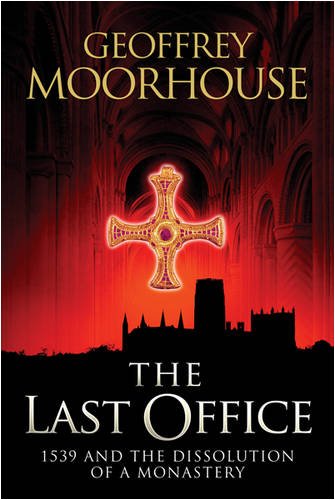
The Last Office: 1539 and the Dissolution of a Monastery
by Geoffrey Moorhouse
283pp, Weidenfeld & Nicolson 2008, £25
St Cuthbert had a lucky start in life; lame at the age of eight, he was cured by an angel who came by on horseback, and who recommended a poultice made of flour and milk. A shepherd and a seer, Cuthbert became abbot of Melrose and Lindisfarne, and after a spell as a bishop took refuge from spiritual sensation-seekers on a tiny and remote island, where he lived with demons, seabirds and seals. He died in 687, and his body, taken to Lindisfarne, became an object of veneration; dug up after 11 years in response to pilgrim demand, the corpse was found to be mummified.
After many adventures, Cuthbert came to rest in Durham, where the great cathedral was in effect built around him, first of timber and then of stone. Pilgrims visited from all over Europe, and the site became fantastically wealthy; to take advantage of the enthusiasm, the saint had two feast days. Cuthbert’s cult became a marker of regional identity, and the prince-bishop of Durham became a figure of national importance; a large community of Benedictine monks guarded the saint’s relics, which included a tooth and a hair impervious to flame. At Flodden in 1513, the English fought beneath Cuthbert’s banner. Only women were excluded from Cuthbertian junkets; a blue marble line in the cathedral pavement kept their polluting influence distant from the holy remains.
In the dark winter days of 1539, Henry VIII’s commissioners arrived to strip the shrine. They took away an emerald which in the previous century had been valued at more than £3,000, and dispatched the priceless Lindisfarne Gospels to distant London. St Bede’s shrine was also at Durham, but when it was opened there was nothing to see. His bones were elsewhere, or had been distributed among the faithful. But the commissioners brought in a blacksmith to smash open Cuthbert’s coffin, and “found him lying whole incorrupt with his face bare and his beard as if it had been a fortnight’s growth, and all his vestments upon him as he was accustomed to say mass withall; and his meet wand of gold lying beside him there”. One leg broken in the raid, the ancient saint was bundled into the vestry for a year or two, till he was re-entombed in plainer style. His emerald was never seen again.
Geoffrey Moorhouse uses the last days of the Durham monks as a case-study of the end of the great monasteries of England. His book will have a particular resonance for those who love Durham, but it is also an intriguing sequel to The Pilgrimage of Grace, his judicious and highly readable history of the complex series of rebellions which in 1536 and 1537 rocked the Tudor throne. The dissolution of the monasteries was an intricate legal process that took place over four years. Master of the telling detail, Moorhouse illuminates and humanises the process, exploring the documents kept so carefully by the men in Durham, who had everything to lose, and the men in London who had everything to gain. The government’s survey of monastic life was chillingly thorough, its commissioners undeterred by rough roads and winter weather. Monks rushed to liquidate their assets, while at Westminster the clerks of the new Court of Augmentations tallied up the loot, installed in their renovated offices and looking out on the terraces and herb garden their master Thomas Cromwell had considerately provided for them.
The formidable Cuthbert apart, this is not a story of heroes. Durham’s bishop, the scholarly mathematician Cuthbert Tunstall, and its prior, Hugh Whitehead, bent pliantly to the wind of change blowing through the country, and served their government as well as their God. The lead from monasteries roofs became bullets, bell metal was beaten into ordnance, and monastic timber made the hulls of men o’ war. But in Durham peace prevailed. Services were held around the broken shrine. Some monks chose to return to the world, and were pensioned. The rest formed the core of the new cathedral foundation.
Moorhouse has to face the difficulty of condensing the history of the English Reformation into a background to his account. Sometimes he is betrayed into glibness: the king’s “coquettish” second wife seems to have strayed in from The Other Boleyn Girl, and he repeats the mistaken belief that Edward VI was “a sickly, consumptive lad from the day of his birth”. If you characterise Henry VIII as a big baby constantly chucking his rattle out of his pram, you miss his dangerous intelligence. One of the small demons who lives in writers’ keyboards has changed the Imperial ambassador, Eustace Chapuys, into Eugene throughout, and there is an impenetrable muddle about the ancestors of Katherine of Aragon.
More seriously, perhaps, Moorhouse characterises the dissolution as simply a great government grab; there was ideology to underlie the avarice, but it is not explored here. These are not major flaws. Moorhouse has wide sympathies, keen judgment, and fine command of a sentence. His absorbing book is charged with the power of time and place; he shows us how to love and value the past – stones and bones, ledgers and law books – without being sentimental, condescending or trite.
Later iconoclasts pulled down Cuthbert’s statue and smashed his stained-glass life-story. In the reign of Edward VI, the dean was Robert Horne, who brought a wife “where never woman came before” – she had the holy water stoups lugged into the kitchens and used them for salting meat and fish. But today Cuthbert lies in state again in the cathedral. Moorhouse is an eloquent witness, wise and measured, to the getting-up and lying-down of his old bones.
